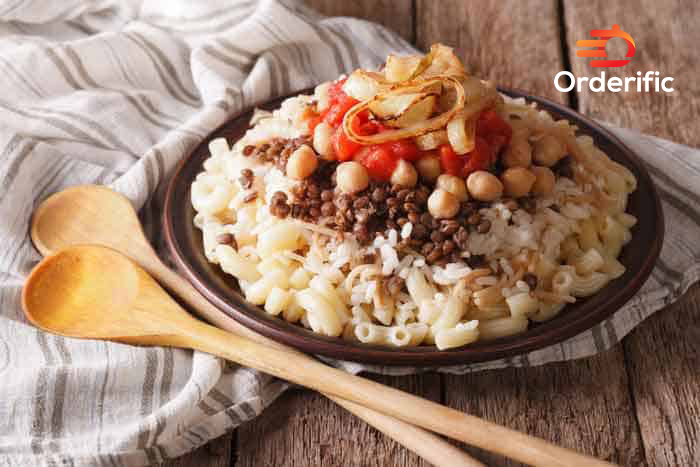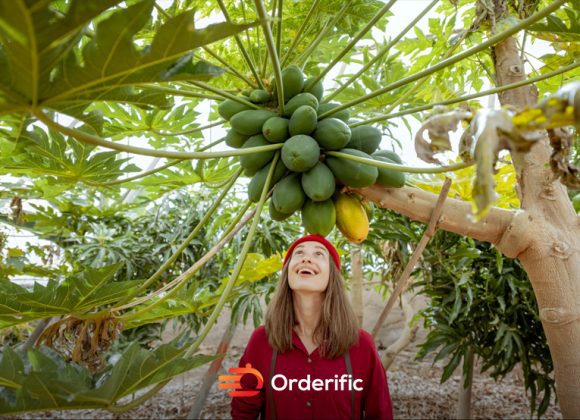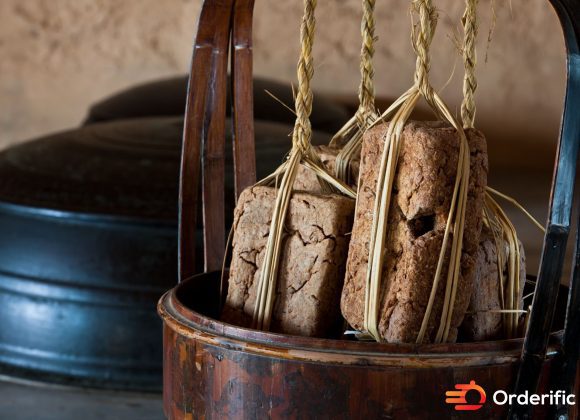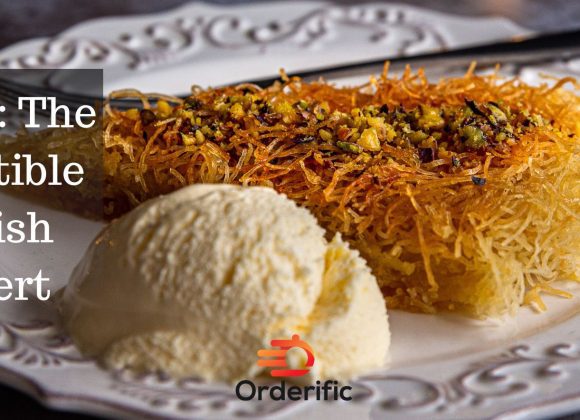For more than a century, locals and visitors to Egypt have savored the dish koshari. It is regarded as Egypt’s national dish and represents its rich culinary tradition.
Koshari is a cultural icon representing Egypt’s rich history and cultural diversity. Everyone loves Koshari, regardless of their social rank or economic background. It is frequently shared with friends and family during social events and festivities as a dish that fosters community.
The dish’s popularity has also led to the emergence of specialized Koshari restaurants that serve different styles and variations. It is often associated with national pride and identity, as it is a unique blend of flavors and ingredients that are distinctly Egyptian.
Koshari’s distinctive fusion of flavors and textures has earned its attention on a global scale. It is the ideal illustration of combining simple ingredients to make a delectable and filling supper.
Origin
Some accounts suggest that the dish was brought to Egypt by Indian soldiers who accompanied British troops during World War I. The dish was initially known as “khichdi,” made of rice and lentil in India.
Some believe that Italian immigrants living in Egypt first prepared the dish. They added pasta which was not traditionally part of the recipe.
Evolution
Over time, koshari has become a beloved part of Egyptian cuisine. It has adapted to suit different tastes and preferences, giving rise to many delicious variations. Whether you’re exploring the streets of Egypt or indulging in a local eatery, you’re likely to encounter the irresistible allure of koshari wherever you go.
Ingredients of Koshari
Koshari is a delicious and filling dish made with a variety of ingredients. The meal is a favorite among Egyptians and cuisine enthusiasts worldwide since each component gives it a distinctive flavor and texture.
Important Tip – When making koshari, it’s essential to cook the rice, lentils, and pasta separately to avoid overcooking or mushiness.
Here are the main components of this tasty dish:
Rice: This recipe’s most desired range of rice is grain rice, which is cooked until smooth and fluffy, then blended with other ingredients.
Lentils: Koshari includes a combination of lentils that are cooked until soft and then blended with different ingredients.
Pasta: Macaroni is the most used kind of pasta for this dish. However, you can additionally use different sorts of pasta.
Tomato Sauce: The sauce is made with a combination of tomatoes, garlic, onions, and spices and cooked till it is thick and flavorful.
Crispy Onions: Crispy onions are a popular topping for Koshari. Fried onions add a crisp texture and savory flavor to koshari.
Preparation
The Egyptian koshari recipe is handy to put together and cook. It’s a hearty vegan mess made with lentil rice, pasta, chickpeas, white ginger, and tomato sauce, and outgunned with crisp skinny fried onion rings.
Here’s step-by-step information on how to put together and cook dinner Koshari.
Most grocery stores carry the ingredients needed to prepare Koshari in stock. You’ll need
· A thinly sliced large onion
· Salt
· 2 cups uncooked brown/grain rice
· 3 cups water
· One teaspoon of salt
· 1 (16-ounce) package of uncooked elbow macaroni
· 1 cup beluga lentils soaked in water
· One tablespoon of vegetable oil, sunflower oil, or onion oil
· 1 (28-ounce) can of crushed tomatoes
· One tablespoon of white vinegar
· One tablespoon of sugar
· One teaspoon of ground cumin
· one teaspoon of ground coriander
· One teaspoon of ground cinnamon
· one teaspoon of ground allspice
· one teaspoon of ground black pepper
Cooking Method
Step 1: Rinse the lentils and soak them for at least 30 minutes.
Step 2. Prepare the rice in a big saucepan with three cups of water and one teaspoon of salt. Bring it to a boil and then simmer it for 18 to 20 minutes.
Step 3. Prepare the macaroni as directed on the packet and drain the water before setting it aside.
Step 4. Place a large skillet over medium heat and add one tablespoon of olive oil. Sauté onion: once the onions are crisp and golden brown, add a pinch of salt and then remove and set it aside from the skillet.
Step 5. Add the lentils to the skillet after draining them. And cook the lentils for around 20 minutes or until soft.
Step 6. In another bowl, mix the mashed tomatoes with the white vinegar, sugar, cumin, ground coriander, cinnamon, cayenne pepper, and black pepper. Now boil the mixture depending on the desired sauce thickness.
Enhance the taste using spices like ground cumin, garlic, chili powder, or herbs like coriander, cardamom, and cinnamon.
Step 7. Mix the cooked rice, fop, and lentils in a big coliseum. Mix thoroughly after adding the tomato sauce. Serve the Koshari in bowls, and remember to top each serving with crispy fried onions, chickpeas, or vermicelli.
Koshari is a delicious, simple, nutritional regale to make and cook. You may store it in the refrigerator for over four days, making it ideal for batch cuisine and meal preparation.
Nutritional Facts
Popular Egyptian food called koshari is both delicious and nourishing. It is a vegan/ vegetarian dish comprising various ingredients that give the body essential nutrients.
Macronutrients
One of the primary sources of body energy and a good supply of carbohydrates is koshari. One serving of koshari (160 grams) contains 6 grams of protein, 4.6 grams of saturated fat, and 47.3 grams of carbohydrates.
Vitamins and Minerals
One serving of koshari contains 18% iron of the daily recommended body intake. It also has about 8% calcium and 9% vitamin C and A of the required daily body intake.
Other Nutrients
Koshari is also a good source of fiber, which is essential for a healthy digestive system. One serving of koshari contains about 28% fiber of the daily body intake.
Variations of Koshari
Koshari is a staple Egyptian dish whose taste varies depending on the ingredients and the cooking style. You may alter this recipe to suit any taste due to its adaptability.
Thanks to its hearty and comforting flavors, Koshari has become a beloved dish globally. Whether you prefer it spicy or mild, with or without meat, a variation of Koshary will surely satisfy your taste buds.
Here are some of the most common variations of Koshari:
- Alexandrian Koshary
Alexandrian Koshary has a unique and distinct taste compared to other variations. It stands out because it uses yellow lentils and a special sauce made with curry and cumin, giving the rice a beautiful and consistent color.
- Cairo Koshary
Cairo Koshary consists of rice, macaroni, and lentils, topped with tomato sauce and fried onions. Some variations include dried chickpeas or garlic to the tomato sauce for extra flavor.
- Port Said Koshary
Port Said Koshary is a flavorful dish that includes the classic ingredients of rice, macaroni, and lentils. You can add vermicelli and chickpeas to the dish and toppings of spicy tomato sauce and crispy fried onions.
- Upper Egyptian Koshary
This koshari variant comprises rice, lentils, and chickpeas. You can serve it with spicy tomato sauce and fried onions.
- Vegan Koshary
Vegan Koshary includes the usual ingredients of rice, lentils, and pasta in vegetable broth. For those following a vegan diet, Vegan Koshary is a perfect choice.
Koshari Around the World
Lately, chefs and food enthusiasts have been on a Koshari adventure, exploring new variations and flavors. They’ve been experimenting with ingredients like quinoa, roasted vegetables, and tofu to create healthier versions that cater to health-conscious individuals seeking a nutritious meal.
Some restaurants have drawn inspiration from the delightful world of Italian cuisine and introduced their spin on Koshari with an Italian-inspired twist. These unique versions include pasta’s deliciousness and parmesan cheese’s richness, giving koshari a distinctive and delightful twist.
Here are a few more examples of how koshari is enjoyed around the world:
● Some restaurants offer a build-your-own koshari bowl, where customers can choose their toppings and sauces.
● Some food vendors offer a spicy version of koshari that includes extra chili sauce or hot peppers.
● Some restaurants offer a gluten-free version of koshari, which uses rice or quinoa instead of cooked pasta.
Some restaurants have experimented with Mexican-inspired koshari, which includes black beans and salsa.
● Some restaurants offer Koshari with additional toppings such as fried onions, hot sauce, or boiled eggs, while others focus on creating a more traditional dish.
Conclusion
In conclusion, Koshari holds a special place in the hearts of people worldwide as a beloved vegan dish from Egypt. Its popularity has transcended borders and cultures, making it a sought-after culinary delight.
This hearty and comforting meal, often found as street food in Egypt, has also found its way into the hearts and menus of other countries, adapting to local tastes and preferences.
Koshari is an excellent option for a filling and nutritious dinner. Protein and fiber, two vital nutrients for the body, are abundant in it. It combines flavor and nutrition to make a genuinely satisfying meal.
What makes Koshari truly remarkable is its versatility. It can take the spotlight as a main course or serve as a delightful side dish. It’s a canvas for personalization, allowing individuals to add extra spices or vegetables according to their taste preferences. Whether you like it mild or spicy, simple or elaborate, Koshari can be adapted to suit your cravings.
In essence, Koshari is known for its deliciousness, nutritional value, and cooking style. Affordability is another appealing aspect of Koshari. It’s a budget-friendly dish that often comes in generous portions, making it perfect for sharing and bringing people together.
For more such popular recipes, please keep checking Orderific blogs and follow us on LinkedIn to stay updated with delicious dishes worth trying from all over the globe.













